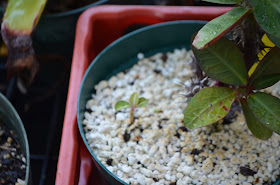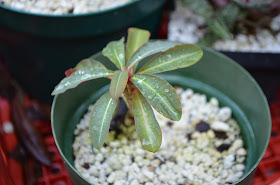Pages
▼
July 31, 2013
July 27, 2013
July 24, 2013
Dyckia unknown or a Orthophytum ?
This was in a pot with Dyckia rariflora Select that came from Tropiflora a few years ago.
Anyone know what it could be?
I just put it in it's own 10 inch pot, lets see how big it could get. It has not flowered as yet.
Anyone know what it could be?
I just put it in it's own 10 inch pot, lets see how big it could get. It has not flowered as yet.
 |
| Dyckia rariflora Select |
Some one said it could be Orth. lucidus. I think he may be right.
Orth. lucidus on the left.
Well I changed my mind, I took another look at it. Orthophytum lucidum does not do stolons. It does look a lot like it though.
What could it be??????????
Uncarina cuttings
Uncarinas are said to be impossible to made cutting of. But not all Uncarina are impossible to root from cuttings.
So far so good with this Uncarina stellulifera. I think it is rooted but I have not dug down in the pot to check.
So far so good with this Uncarina stellulifera. I think it is rooted but I have not dug down in the pot to check.
Uncarina's that have not made roots for me from cutting are Uncarina grandidieri and Uncarina roeoesliana.
Anyone had any luck with cutting?
.JPG) |
| cutting came from this plant |
- As with the other Uncarinas, cuttings do form a caudex.
- Uncarina grandidieri can reproduced by cuttings as well.
After reading the this é I am going to try to
root Uncarina grandidieri and Uncarina decaryi.
Uncarina grandidieri
it seems is the only one with all yellow flowers and I only have one of
them.
Uncarina decaryi has
the best looking leaves the flowers are like most, yellow with a red throat . Plus I only have one and 2 would be better.
July 23, 2013
Operculicarya decaryi
A thick bumpy and twisted trunk that can have zigzagging
branches and alternate odd-pinnate leaves with tiny shiny dark green rounded
leaflets.
In its native habitat in Madagascar.
It is a drought deciduous tree to nearly 30 feet tall with a
3 foot wide trunk
Mature plants can have small reddish to brown flowers at the
tips of the branches in late winter. Male and female flowers on separate plants.
Plant in full to partial sun in a well-drained soil and
water only normal in summer months less in winter. I have seen any flowers on my plant.
This plant is about 3 1/2 feet hight. But I keep cutting it back.
July 22, 2013
July 20, 2013
Dyckia ferox
Do you know their is no photo of this plant on http://fcbs.org/ ?
Don't know why that is, it's been around for some time.
The only reason I can think is, it a hard plant to have it look good (for me).
This is one of those dyckia's that make Stolons.
My kind of dyckia, you can take off the offsets with
donating blood doing so.
Don't know why that is, it's been around for some time.
The only reason I can think is, it a hard plant to have it look good (for me).
This is one of those dyckia's that make Stolons.
My kind of dyckia, you can take off the offsets with
donating blood doing so.
July 19, 2013
July 16, 2013
Catopsis in flower
I think this is Catopsis
floribunda. It looks like it to me.
Catopsis are hard to come by.
I have seen the Catopsis listed below for sale but rarely.
Catopsis berteroniana, Catopsis nutans, Catopsis morreniana, Catopsis hahnii and Catopsis subulata.
This one I've had for a few years. I just have it hanging in a shade and leave it be.
Tropiflora just had a Catopsis juncifolia on it's
VIPP Special list but it sold out fast.
Catopsis are hard to come by.
I have seen the Catopsis listed below for sale but rarely.
Catopsis berteroniana, Catopsis nutans, Catopsis morreniana, Catopsis hahnii and Catopsis subulata.
This one I've had for a few years. I just have it hanging in a shade and leave it be.
July 15, 2013
Euphorbia millotii
This is the second Euphorbia millotii the first
one I had froze out a few winters ago.
The first one grow well for the 3 of 4 years that I had it, but it never produced any seedling. This second Euphorbia millotii I got last year and this summer seedling are coming up every where. With no special care the seedling are growing in pot near by.
The first one grow well for the 3 of 4 years that I had it, but it never produced any seedling. This second Euphorbia millotii I got last year and this summer seedling are coming up every where. With no special care the seedling are growing in pot near by.
 |
| Euphorbia millotii seedling with Moon Glow |
 |
| Euphorbia millotii seedling |
 |
| Euphorbia millotii seedling |
 |
| Euphorbia millotii seedling |
 |
| Euphorbia millotii seedling |
July 14, 2013
Stapelia
Stapelia or plants like Stapelia's are not to easy grow in this part of FL. They don't like all the rain we could get in the summer.
Stapelia grandiflora and Stapelia leendertziae (not pictured) can grow in the ground if you can keep them out of any rain that will made a puddle there they are growing. They like to be high and dry.
Stapelia leendertziae was growing with Stapelia gigantea but rotted out due to heavy rains one year.
 |
| Stapelia ? |
.JPG) |
| Stapelia grandiflora |
 |
| Stapelia grandiflora |
Stapelia leendertziae was growing with Stapelia gigantea but rotted out due to heavy rains one year.
 |
| Stapelia ? |
July 11, 2013
The article below is from Saddleback
Valley Bromeliad Society Newsletter in California.
It was a word Doc. that I cut and pasted the words but the photos I could not do the same to. So I used my photos.
DYCKIA EXCEPTIONS
Dyckia
choristaminea is one
exception to consider. Spines are not
as much a problem here. True, this
native of dryer Brazilian areas such as Rio Grande do Sul has leaf spines, but
as seen at right they can be smaller, finer, and less lethal than those on many
Dyckia.
This relatively smaller plant features
long thin leaves which are often darker than they appear in the very strongly
lit photo at right. In natural
lighting, focusing on one plant in this densely clumping, green species becomes
difficult. Each plant forms a rosette
of many 6 inch long leaves that overlap other cluster members. The owner of the cluster in the above left
photo says they “believe” it contains 15 plants. One grower, probably searching for a catchy name to sell plants,
called this the “spaghetti bowl” Dyckia
Dyckia chotistaminea flowers top a 10 inch flower spike and
these blooms are larger than those of most Dyckia. Flowers can reach 2/3 of an inch long and are usually yellow like
those in the photo. Orange flowers are
also reported. Flowering time is
generally May/ June. They are said by
some to be fragrant.
As frequently
found in rarer plants, there is not a lot of information in our books. The internet adds sometimes conflicting
information. For example, there are a
few mentions that this plant is sterile and will not bloom. However, other articles have pictures of
flowers (like that taken by George Allaria below.) Some of our friends have succeeded in flowering this plant yearly
and some of us have yet to succeed
It was a word Doc. that I cut and pasted the words but the photos I could not do the same to. So I used my photos.
PUP TALK
THE
SADDLEBACK VALLEY BROMELIAD SOCIETY
Volume 23,
Number 5
May 2013
We usually picture Dyckia as
upright, extremely well-armored, neatly formed rosette-shaped plants with a
very strong root system which are a “bear” to handle and repot. An example might be Dyckia fosteriana pictured at right. This well-known species is a
parent of several popular cultivars such as Dyckia ‘’Brittle Star.’
But as often found with general concept,
there are exceptions. Below are two
Dyckia species which might be somewhat easier to handle when they enjoy a place
in your collection.
Puptalk May 2013 p 6
The above left photo also gives a better
impression of the leaf color under natural light. The leaves will blush plum red with sufficient light exposure.
Another exception is Dyckia estevesii. Instead of the expected rosette-shaped
plant, this fan-shaped Dyckia features leaves in parallel rows and grows on its
side almost horizontally once pups appear. Prior to pupping, it forms an
upright fan. The fans can reach between
2 to 3 feet across. This special plant
is found only in the vicinity of Goias, Brazil. It was named for its discoverer, Eddie Estavis Pereira by Rauh.
Carol and I obtained our plant
from a friend who said we would find the plant’s growth habit
“interesting.” He was very right.
The horizontal shape of this plant
offers handling advantages for repotting.
However, like most Dyckia, this plant presents a mass of strong roots
and is very well-armored. Strong
self-protection and a root saw are suggested for those separating or repotting
it.
The future of Dyckia estevesii may
be uncertain. Derek Butcher, well known
bromeliad writer, said in a 2010 article that to his mind this plant can be
likened to the monstrous or crested cacti forms. If he is proven correct by future DNA analysis, this plant might
be relegated to a form of another species.
As we often say, stay tuned.
Both of these plants will easily winter
outside in this area but restrict watering prior to extra cold nights. Joe
Puptalk May 2013 p 7













.JPG)
.JPG)
.JPG)
.JPG)








